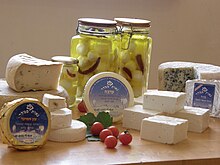

An animal product is any material derived from the body of a non-human animal.[1] Examples are fat, flesh, blood, milk, eggs, and lesser known products, such as isinglass and rennet.[2]
Animal by-products, as defined by the USDA, are products harvested or manufactured from livestock other than muscle meat.[3] In the EU, animal by-products (ABPs) are defined somewhat more broadly, as materials from animals that people do not consume.[4] Thus, chicken eggs for human consumption are considered by-products in the US but not France; whereas eggs destined for animal feed are classified as animal by-products in both countries. This does not in itself reflect on the condition, safety, or wholesomeness of the product.
Animal by-products are carcasses and parts of carcasses from slaughterhouses, animal shelters, zoos and veterinarians, and products of animal origin not intended for human consumption, including catering waste. These products may go through a process known as rendering to be made into human and non-human foodstuffs, fats, and other material that can be sold to make commercial products such as cosmetics, paint, cleaners, polishes, glue, soap and ink. The sale of animal by-products allows the meat industry to compete economically with industries selling sources of vegetable protein.[5]
The word animals includes all species in the biological kingdom Animalia, including, for example, tetrapods, arthropods, and mollusks. Generally, products made from fossilized or decomposed animals, such as petroleum formed from the ancient remains of marine animals are not considered animal products. Crops grown in soil fertilized with animal remains are rarely characterized as animal products. Products sourced from humans (ex; hair sold for wigs, donated blood) are not typically classified as animal products even though humans are part of the animal kingdom.
Increased production and consumption over the past 50 years has led to widespread environmental and animal welfare impacts. These range from being linked to 80% of Amazonian deforestation[6] to the welfare implications of using chick culling shredders on live day old-chicks for 7 billion of them each year.[7]
Several popular diet patterns prohibit the inclusion of some categories of animal products and may also limit the conditions of when other animal products may be permitted. This includes but not limited to secular diets; like, vegetarian, pescetarian, and paleolithic diets, as well as religious diets, such as kosher, halal, mahayana, macrobiotic, and sattvic diets. Other diets, such as vegan-vegetarian diets and all its subsets exclude any material of animal origin.[8] Scholarly, the term animal source foods (ASFs) has been used to refer to these animal products and by-products collectively.[9]
In international trade legislation, the terminology products of animal origin (POAO) is used for referring to foods and goods that are derived from animals or have close relation to them.[10]
- ^ Gilman, Daniel Coit; Peck, Harry Thurston; Colby, Frank Moore (1907). The New International Encyclopædia. Dodd, Mead & Co. p. 474.
- ^ Unklesbay, Nan. World Food and You. Routledge, 1992, p. 179ff.
- ^ "USDA ERS - Glossary". Archived from the original on February 2, 2017. Retrieved January 20, 2017.
- ^ "Animal by-products". Archived from the original on January 15, 2021. Retrieved January 20, 2017.
- ^ Ockerman, Herbert and Hansen, Conly L. Animal by-product processing & utilization. Technomic Publishing Company Inc., 2000, p. 1.
- ^ Skidmore, Marin Elisabeth; Moffette, Fanny; Rausch, Lisa; Christie, Matthew; Munger, Jacob; Gibbs, Holly K. (April 2021). "Cattle ranchers and deforestation in the Brazilian Amazon: Production, location, and policies". Global Environmental Change. 68: 102280. doi:10.1016/j.gloenvcha.2021.102280. ISSN 0959-3780.
- ^ Krautwald-Junghanns, M-E; Cramer, K; Fischer, B; Förster, A; Galli, R; Kremer, F; Mapesa, E U; Meissner, S; Preisinger, R; Preusse, G; Schnabel, C; Steiner, G; Bartels, T (November 17, 2017). "Current approaches to avoid the culling of day-old male chicks in the layer industry, with special reference to spectroscopic methods". Poultry Science. 97 (3): 749–757. doi:10.3382/ps/pex389. ISSN 0032-5791.
- ^ Stepaniak, Joanne. Being Vegan: Living with Conscience, Conviction, and Compassion. McGraw-Hill Professional, 2000, p. 7.
- ^ Adesogan, Adegbola (October 14, 2019). "Animal source foods: Sustainability problem or malnutrition and sustainability solution? Perspective matters". Global Food Security. 25: 100325. doi:10.1016/j.gfs.2019.100325.
- ^ "Animals and animal products: international trade regulations". Archived from the original on January 14, 2021. Retrieved August 6, 2018.